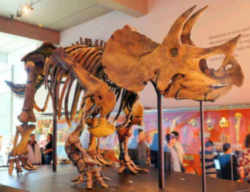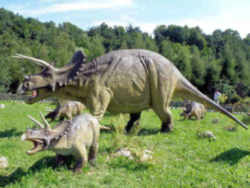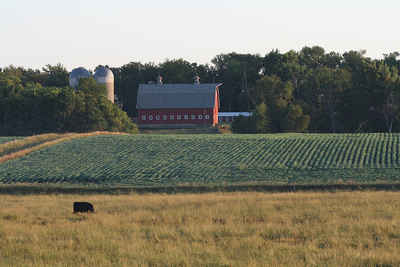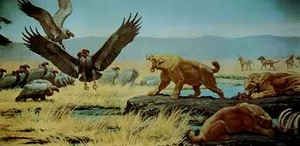South Dakota State Fossil
Triceratops

(Triceratops)
Adopted in 1988.
Prior to 1988, the state fossil of South Dakota was the cycad, a type of palm like Mesozoic plant known from Cycad National Monument near Minnekahta. However, illegal collecting destroyed the Monument, causing both the park and the cycad to lose their official status. In 1988, the State Legislature decided to designate Triceratops, (Triceratops,) the state fossil of South Dakota in the cycad's place.
North Dakota State Fossil:Triceratops

Triceratops (Greek for "three-horn face") is a genus of herbivorous ceratopsid dinosaur that first appeared during the late Maastrichtian stage of the late Cretaceous period, about 68 million years ago (Mya) in what is now North America. It is one of the last known non-avian dinosaur genera, and became extinct in the Cretaceous-Paleogene extinction event 66 million years ago. The term Triceratops, which literally means "three-horned face", is derived from the Greek.
The "three-horned face" triceratops of the late Cretaceous period (approximately 68 million years ago as the Western Interior Seaway that divided the continent was retreating to the south. ), is the state fossil and roamed the land that is now South Dakota. It was a vegetation-eating dinosaur and used its horns for defense. Discovered in Harding County in 1927, the skeleton is now on display in the Museum of Geology in Rapid City.
Dinosaurs were known principally from two areas in South Dakota: along the ridge known as the Hogback that forms the outer boundary of the Black Hills; and in the counties of the northwestern corner of the state. From the Hogback ridge, dinosaurs have been recovered from rocks of the late Jurassic and early Cretaceous periods. Appropriately, Dinosaur Park in Rapid City is built on this ridge. The northwestern corner of the state has produced most of the dinosaurs found in South Dakota.

Dinosaurs lived in South Dakota during the late Jurassic Period, about 150 million years ago, the early Cretaceous Period, about 125 million years ago, and late Cretaceous Period ranging from 80 to 66 million years ago. South Dakota, at the time of the dinosaurs, was a very different place. South Dakota dinosaur habitats included broad open flood plains, shores along sandy bottomed streams that were well removed from the oceans, and land along coastal plains and rivers at the upper end of deltas. (At the time of the dinosaurs, part of South Dakota was covered by an inland sea, as evidenced by our finding marine fossils in the state today.) The climate at the time of the dinosaurs was probably warmer and more moist than what we currently experience in South Dakota.
This dinosaur species was first known from a single partial horn, which Marsh named Bison alticornis in 1889. John Bell Hatcher, a collector in Marsh's employ, traced the original horn to eastern Wyoming and proceeded to collect many skulls for Marsh. Marsh, Hatcher and Lull wrote a book in 1907 on all horned dinosaurs known at that time. Today, that book remains an important document for those studying horned dinosaurs. The current scientific name, Triceratops , means three-horned face.
The Triceratops skull was very distinctive, with two brow horns and a single nasal horn. The latter was considerably shorter than the brow horns. The eye socket was very large, suggesting that sight may have been an important sense to the animal. The eyes were directed to the sides of the animal to widen the field of view. Triceratops was a member of the ceratopsian lineage of dinosaurs as the back of the head had a fan-like frill of very thick bone that served to protect the neck and give the animal the appearance of being much larger when viewed from the front. Powerful jaw-closing muscles may have attached to the frill as well. The neck ligaments and muscles were attached to the base of the frill above the opening for the spinal cord. The outer edge of the frill had small triangular bones to give the frill a saw-toothed appearance. Skulls ranged in size from very small baby skulls up to adult skulls 2.7 yards (2.5 meters) in length. The animal's large size - up to 8.7 yards (8 meters) long and about 8,800 to 11,000 pounds (4,000 to 5,000 kilograms) in weight for adults - combine to make this dinosaur fossil quite impressive.
South Dakota Codified Laws
The law designating theTriceratops as the official South Dakota state fossil is found in the South Dakota Codified Laws, Title 1, Chapter 1-6, Section 1-6-16.1.
TITLE 1 STATE AFFAIRS AND GOVERNMENT
CHAPTER 1-6 STATE EMBLEMS
1-6-16.1 State fossil.
1-6-16.1. State fossil. Triceratops is hereby designated as the official fossil of the State of South Dakota.
Source: SL 1988, ch 6; SL 1989, ch 30, § 2.
Taxonomic Hierarchy: Triceratops
Kingdom: AnimaliaPhylum: Chordata
Order: †Ornithischia
Family: †Ceratopsidae
Subfamily: †Chasmosaurinae
Tribe: †Triceratopsini
Genus: †Triceratops Marsh, 1889
Type species: †Triceratops horridus Marsh, 1889
Species
†T. horridus Marsh, 1889
†T. prorsus Marsh, 1890

Some states that lack a "state fossil" have nevertheless singled out a fossil for formal designation such as a state dinosaur, rock, gem or stone.







